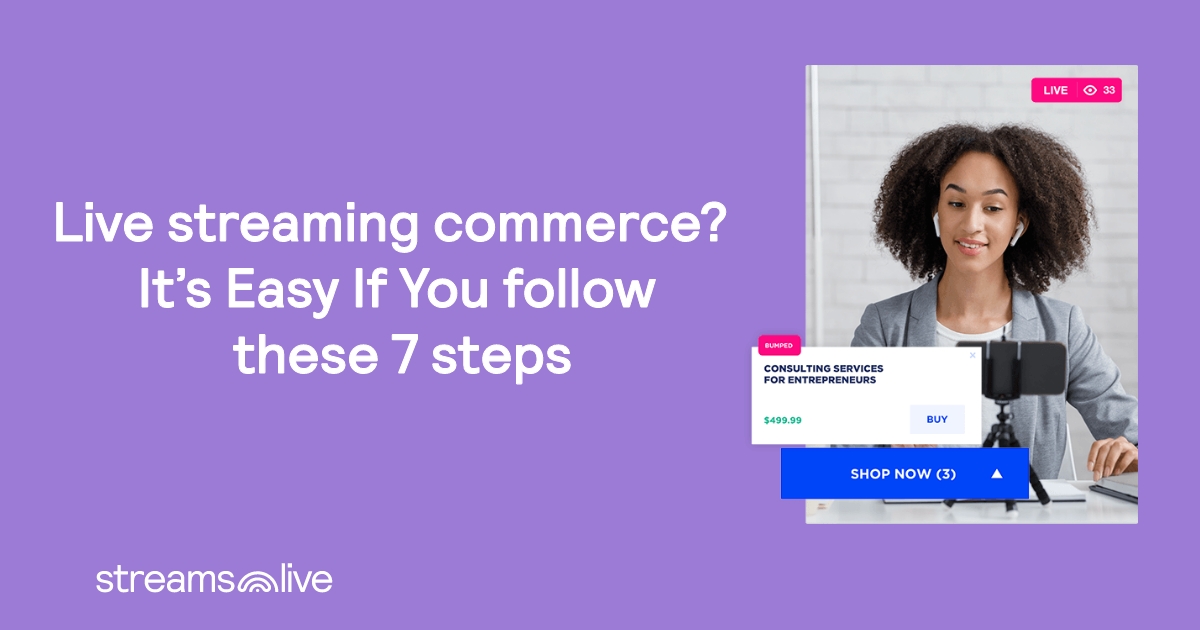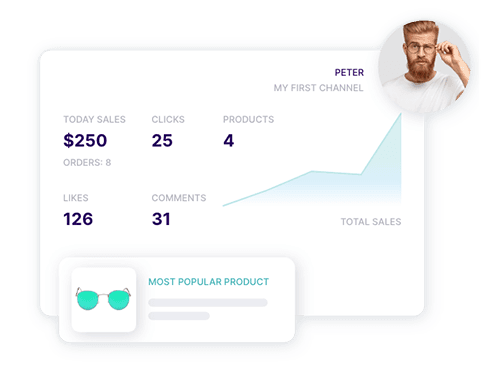
Things are hard until they are not…Putting it differently, new beginnings are not the easiest things that we put in front of. The same thing applies to live streaming commerce – the trend also known as live shopping, used by brands to go live in front of their audiences, showcase products, and sell. It’s a mix of in-store and online commerce, as it takes the best from both experiences. You still benefit from an eCommerce experience, where you purchase the goods from the comfort of your home – and have them delivered at your doorsteps. But at the same time, you still have that realistic and engaging experience that, before now, you could only find in a brick-and-mortar store. You can interact live with a shop assistant, ask questions, and see the product from different angles. It helps you get a better understanding of what you want to buy. And that is priceless.
We’ve seen eCommerce live stream experiences over the internet – either embedded in a brand’s website or straight on live commerce platform. Maybe on social media. You understand the benefits of adopting a live commerce strategy, but you may think that it’s hard to implement.
This article is meant to show you that implementing live streaming commerce is easy, as long as you follow these 7 steps.
1. Set a goal and create a plan
Of course, the ultimate goal for us all is having a thriving business, all while we find that our meaningful work is making the world a better place. More or less. But until we reach that point, we have to take a lot of small decisions. And live commerce makes no difference. Before hosting live eCommerce sessions, you should decide what you want to gain and what should be the correct strategy to reach your goal(s).
Do you want to push the focus entirely on sales? In this case, maybe the better strategy would be hosting big Shoppertainment shows, hosted by one or even several top influencers. These sessions are generally hosted around the well-known shopping sprees, like major Holidays and Black Friday. And aim at getting as many viewers as possible on the live shopping event – mainly through paid marketing, also offering discounts and rewards during the live show.
On the other hand, you may want to adopt a strategy that uses e-commerce live streaming to create a community around your brand. In this case, the focus will be on live sessions hosted by brand representatives, hosted weekly, where the brand uses the opportunity not just for selling, but to communicate with customers and share their values and vision.
This doesn’t mean that you cannot use both of these strategies. What I am saying is that you should know exactly what you want to gain from your next live commerce show.
2. Prepare your live eCommerce session
“Failing to prepare is preparing to fail”
Benjamin Franklin
Once you have decided on what you want to gain, you should start preparing your live shopping session.
Decide on the products that you want to sell and how they are used together. With live eCommerce, it’s easy to showcase complementary products thus helping customers understand how to use them together and increasing the shopping cart value.
Will the experience be streamed from a dedicated studio, from home, from a store, or a warehouse? How will the background look? What equipment will be used? These options depend on the format that you have chosen and you need to prepare everything in advance.
Think about who is going to perform in front of the camera and create a script. Although customers value this online shopping format that facilities authenticity, nobody would be delighted to see the host stuttering. Body language is also important when presenting in front of an audience, and someone with little experience can read more about this in our past article.
From a technical perspective, our live commerce software allows you to easily embed the experience into your website or marketplace. You can go live using a day-to-day smartphone, camera, or by working with a professional filming crew. Create your channel, add your products, embed the experience, and go live. But not without previously preparing and testing the entire experience.
3. Communicate

Communication is a crucial part of any live shopping session – it will never be a successful one if your potential customers don’t join. Share the great news and invite people to join, regardless of where the experience will take place – your website, a marketplace that you use to sell your products, or even a partner’s platform.
A good practice is to share the news as soon as possible. Our live commerce software will allow people to register for notifications through email, SMS, or calendar, dramatically decreasing the no-show rate.
A proven tactic that we recommend is going live on the social media channel (eg. Instagram) 5 minutes before the start of the shopping event. And encouraging people to join the URL where the full experience will take place. Although social media channels help you reach broader audiences, the shopping experience is fragmented as customers cannot buy or add products to their shopping carts straight from these platforms.
If you are looking for a more in-depth article on this particular subject please check out our post focusing on how to promote your live shopping events.
4. Engage your viewers during the live session
One of the main reasons for which live stream shopping is so efficient is that it facilitates live communication between you and your customers. While purchasing online, 80% of customers have at least one question regarding your product, delivery options, or refund policy. And they need to find an answer to it before actually making the purchase.
A live experience encourages viewers to interact and ask these questions, and you and your support team can answer them on the spot! Depending on the host of the video and the relevance of these questions, answers can be shared either by the host or by the support team – using the chat function. The main takeaway here is that these answers will help all of your viewers, not just the ones that ask them – the two-way communication channel also acts as a dynamic FAQ section for your viewers.
Another good practice is to multicast the video experience to owned or third-party social media channels. By using this feature, you can reach broader audiences and bring new traffic to your actual live e-commerce channel. Although customers cannot buy from there, they can see the actual live video and those interested can easily access to full experience on the website hosting it.
5. Use the recorded experience
After the live event ends, you can (and should!) use it for both sales and marketing purposes.
Many of those interested in the show couldn’t make it to the live – something life gets in the way. But you can invite them to watch the pre-recorded version, having the option to buy the products straight from these shoppable videos. They will see your products being showcased through video, helping them get a better understanding of their actual feel and look. They can see the questions fellow customers asked during the live and most importantly, they can see the answers they received. Although not live, the prerecorded video is still offering an enhanced shopping experience where customers can skip straight to the parts they are interested in and effortlessly buy the desired products.
Your video content can be used throughout different distribution channels to promote your business, special products, or your future live shows. You can create short video series for your social media channels to promote specific products. You can curate the content and add very short pieces to your product pages so customers can see them being showcased. Or you can use it to promote your future live shopping sessions – reaching new audiences and showing them what they should expect from this new way of shopping. The possibilities are countless.
6. Analyze, learn, and implement

Online interactions allow us to collect relevant sets of data to better understand how our visitors interact with our platforms. With the right strategy, eCommerce businesses see the entire customer’s journey, understanding which touchpoints need to be improved to increase conversions.
Creating live commerce campaigns will allow you to collect and analyze the data and make improvements. Of course, you check their efficiency by ultimately looking at the total number of sold products. But that’s just scratching the surface.
Your total number of viewers will tell you about the efficiency of your marketing campaigns. You can understand more about how viewers receive your content by checking the total number of chat posts and asking questions. You can see if they liked it by the total number of “hearts” (or likes). Or, for complex sessions with thousands of comments, you can implement Live Brain, our AI solution used for sentiment analysis.
Check the product engagement ratio to understand which are the products your viewers love. Compare the add-to-cart statistics to final checkouts – are customers dropping off because the payment process is too complicated? Or maybe the shipping costs are stopping them, although your products are exactly what they are looking for.
7. Repeat your live stream commerce session
Like any other successful strategy, eCommerce live streaming requires consistency from your side. After analyzing and learning what went really well and where there is still room for improvement, implement the required changes and do it again. “Repetition is the mother of learning”, meaning that by following the steps mentioned above you can deploy better and better experiences to your community. It’s important to learn from others when working to reach your goals. But nothing is more important than learning from your past and delivering better results with every chance that you get.
Final words
Live eCommerce is rather a new concept, but it is undoubtedly the future of digital (and in-store) shopping. More and more businesses adopt it and radically transform the customer journey into an interactive, engaging experience. By following these 7 steps, you can add a live streaming commerce strategy to your business with ease.





